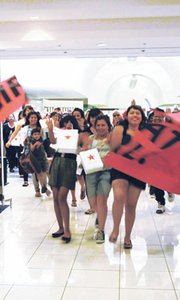The Art of the Exclusive
Exclusive product can set a store apart from the competition, but the rules for landing an exclusive deal have changed in the new economy.
Exclusives—product sold exclusively at one retailer—are back, and, according to trade show producer and showroom owner Jason Bates, it’s a sign that the economy is making a comeback.
“When you have an exclusive, it says you are doing business again,” said Bates, who produces the Class Trade Show and Class@ASR events and runs multi-line showroom Derelicte.
Earlier this year, Bates noticed buyers at Class and Class@ASR making requests to be the exclusive retailers for certain brands in a specific territory. The last time he heard a big group of buyers and stores ask for exclusives was before the Great Recession.
To ask for exclusive rights to sell a fashion line in a certain territory means a store must place a substantial order for a fashion line—and deliver on promises to sell-through the line. Only then does the retailer attain the right to exclusively sell a certain territory, which is typically the street where the retailer’s store is located.
Landing exclusive product is not new, but the practice has changed in recent years. These days, retailers say it’s a more competitive game with higher stakes.
Department stores and majors have been focusing more on making exclusivity deals with emerging brands and brands with a celebrity name, said Lynne Sperling, a retail consultant for Sperling & Hileman Group LLC in San Marino, Calif.
Macy’s made headlines this year as being the exclusive outlet for pop star Madonna’s Material Girl line, as well as merchandise inspired by the “Glee” TV show. JCPenney announced in August that it will be the exclusive place to buy Liz Claiborneshy; fashion.
If better department stores make themselves unique by being the go-to places for prominent fashion labels such as Theory and Juicy Couture, store buyers make their merchandise selection more compelling by surrounding the well-known labels with exclusives for the hot, emerging brands, Sperling said.
As a result, department stores are increasingly stepping into specialty stores’ territory.
Don Zuidema, co-owner of the LASC boutique in West Hollywood, Calif., said competition from majors makes the game of getting exclusives more complex. With a weaker economy, many designers and manufacturers told Zuidema that they needed to prove themselves quicker and make more money in a shorter period of time.
Zuidema said manufacturers will say, “We need to get our first season into a major.”
These days, securing exclusive deals is much more difficult for specialty stores,” Zuidema said. “It means that we may have to compete on price point and promotionally with majors,” he said.
The balance of power has changed, too. When the economy was good and there were more lines competing for greater shelf space, vendors were much more apt to award exclusives.
With fewer retailers doing business since the recession—and many keeping inventories lean—vendors cannot afford to lose any sales, so they are less willing to grant one boutique an exclusive, said Reneeacute; Tenison, co-owner of Varga, a four-store chain headquartered in Los Angeles. (In November, Varga debuts an e-commerce boutique at www.vargastore.com.)
Despite the challenges, exclusives are still crucial to almost any retailer, said Gila Leibovitch, co-owner of the Premier Men boutique and several other stores with different nameplates in Los Angeles and Laguna Beach, Calif. “We need to stay unique and offer product that no one else has, especially the small, up-and-coming brands,” Leibovitch said.
Anatomy of an exclusive deal
The race to find hot, emerging brands often starts at trade shows. Typically, a boutique will make a deal at a show to test the line, and if it performs well enough, the retailer might request an exclusive. Deals are sealed informally, typically with an e-mailed confirmation of the exclusive or, at most, a rudimentary, one-page contract.
Exclusive deals could last for a minimum of a year, but if the partnership between store and vendor is particularly fruitful, it could last more than a decade. If a boutique owner discovers the terms of the deal have been broken—perhaps a neighboring store is selling the exclusive brand—the owners may send their inventory back to the vendor or ask for discounts or trade their inventory for newer merchandise.
Terms of the contracts are as individualized as the retailers making them. According to Tenison, Varga’s exclusives entail deep orders of 75 to 100 pieces per style, per color of an item. “It’s only stuff that I’m 100 percent sure I can distribute throughout my stores,” she said.
For LASC exclusives, Zuidema will not buy as heavily, but he and his partners will buy many pieces throughout the collection. “It might be like someone buying the better part of a line. They’re making a total investment,” Zuidema said.
In some exclusive deals, retailers are expected to produce promotional events such as a space in the shop devoted to the exclusive brand, store parties and e-mail blasts to put the exclusive line on their clients’ radar screens. Manufacturers often help out with costs for parties, which could range from $300 for refreshments at a trunk show to thousands of dollars for a gala event.
Bates, the Derelicte showroom owner and Class founder, said an exclusive can lead to great sales. “If [retailers] run an exclusive, they value the line,” he said. “You want partners like that.”
























